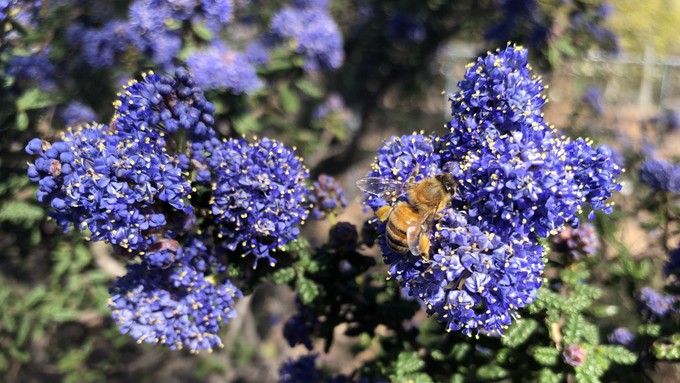
Open Garden Day this month is on Wednesday morning

The ceanothus is in bloom at the Fair Oaks Horticulture Center, and the bees know it. Kathy Morrison
The weather crimped the calendar for plants as well as for people this year. But having experienced some days of sunshine now, the natives and other perennials beginning to bloom, as are the blueberries, the scented geraniums and the fruit trees.
All this botanical activity and more will be on display Wednesday, April 12, when the master gardeners open the gates to the Fair Oaks Horticulture Center for Open Garden Day. The event runs from 9 a.m. to noon and is free to the public.
The Horticulture Center is the showcase for the UC master gardener program in Sacramento County. It features several focus gardens, including an orchard, vegetable garden, herb garden, vineyard, berry garden and compost demonstration area.
The Water Efficient Landscape, in the front of the center, features many native plants and other plants that are water-efficient and appropriate for home gardens. The WEL is open daily, but the other areas are open only during Open Garden days and Harvest Day (that's Aug. 5 this year).
Visitors are welcome to stroll the grounds, be inspired by the plantings and, especially, ask questions of the many master gardeners who will be working in the gardens. The Ask a Master Gardener table will be staffed to help gardeners with their plant problems or mysteries. (Bring samples!)
Additional Open Garden days this spring are scheduled on May 4 (4-7 p.m.); May 20 (9 a.m. to noon) and June 17 (9 a.m. to noon). The Horticulture Center is located at 11549 Fair Oaks Blvd., just south of Fair Oaks Park and Fair Oaks Library off Madison Avenue.
Find more about the Sacramento County master gardener programs and events at sacmg.ucanr.edu.
----
Note: Due to operator error (mine), the Wednesday blog post, about the Sherwood Demonstration Garden in Placerville, didn't go out in the newsletter as it usually does. Readers can find it here:
https://sacdigsgardening.californialocal.com/article/32724-open-gardens-eldorado-sales/
Comments
0 comments have been posted.Sacramento Digs Gardening to your inbox.
Food in My Back Yard Series
May 6: Maintain soil moisture with mulch for garden success
April 29: What's (already) wrong with my tomato plants?
April 22: Should you stock up on fertilizer? (Yes!)
April 15: Grow culinary herbs in containers
April 8: When to plant summer vegetables
April 1: Don't be fooled by these garden myths
March 25: Fertilizer tips: How to 'feed' your vegetables for healthy growth
March 18: Time to give vegetable seedlings some more space
March 11: Ways to win the fight against weeds
March 4: Potatoes from the garden
Feb. 25: Plant a fruit tree now -- for later
Feb. 18: How to squeeze more food into less space
Feb. 11: When to plant? Consider staggering your transplants
Feb. 4: Starting in seed starting
Sites We Like
Garden Checklist for week of May 4
Enjoy this spring weather – and get gardening!
* Plant, plant, plant! It’s prime planting season in the Sacramento area. Time to set out those tomato transplants along with peppers and eggplants. Pinch off any flowers on new transplants to make them concentrate on establishing roots instead of setting premature fruit.
* Direct-seed melons, cucumbers, summer squash, corn, radishes, pumpkins and annual herbs such as basil.
* Harvest cabbage, lettuce, peas and green onions.
* In the flower garden, direct-seed sunflowers, cosmos, salvia, zinnias, marigolds, celosia and asters. (You also can transplant seedlings for many of the same flowers.)
* Plant dahlia tubers. Other perennials to set out include verbena, coreopsis, coneflower and astilbe.
* Transplant petunias, marigolds and perennial flowers such as astilbe, columbine, coneflowers, coreopsis, dahlias, rudbeckia and verbena.
* Keep an eye out for slugs, snails, earwigs and aphids that want to dine on tender new growth.
* Feed summer bloomers with a balanced fertilizer.
* For continued bloom, cut off spent flowers on roses as well as other flowering plants.
* Add mulch to the garden to maintain moisture. Mulch also cuts down on weeds. But don’t let it mound around the stems or trunks of trees or shrubs. Leave about a 6-inch to 1-foot circle to avoid crown rot or other problems.